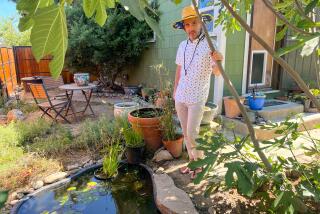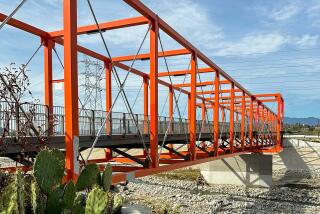History and Art Flow From Rome’s Fountains
- Share via
ROME — They were counted among the hand-wrought treasures of the planet and numbered more than 1,000 in a city that commanded the civilized world. They were created by the greatest artists of their time and have succored popes, poets, thieves and lepers. They have given refreshment and joy to Keats, Michelangelo, Milton, Bonnie Prince Charlie, Sophia Loren, Velazquez and G.I. Joe. It’s been said that no greater compliment has ever been paid by rulers to their people than the gift of these beautiful poems in stone and water.
They are the fountains of Rome.
They serve today as they did 2,000 years ago when ordered into existence by the Caesars. The traveler pauses to slake his thirst, the workman to cool his brow, the child to launch a toy boat.
Neighborhood women come to fill pots--as did the vestal virgins of far time. Tourists toss coins into their pools, few realizing that this wishing-well custom is rooted in the spirit-worship of antiquity. Their marbles are pitted and veined from the ages, their rims polished smooth by countless pilgrims settling to rest.
The politics, pleasures and problems of centuries have been discussed on these stones, and they live everywhere on numberless post cards and snapshots.
The fountains are fed by aqueducts originating at springs and lakes as far as 50 miles away. The oldest was the Aqua Appia, built about 300 BC and with most of its 10 miles running underground through stone cut by slaves.
By the first invasion of the Goths in AD 410, 11 such conduits were feeding 1,212 fountains and 1,000 public baths. No metropolis before or since has enjoyed such a plethora of sweet water. The emperors Augustus, Claudius, Trajan and Severus had all contributed aqueducts that were pouring a veritable Niagara into the baths, fountains and sewers of the city before emptying into the River Tiber.
Marcus Agrippa, who defeated Antony and Cleopatra, was the champion aquarii of the lot. In one year, about 30 BC, he built an astonishing 500 fountains, embellishing them with 300 marble and bronze statues and 500 columns. Sadly, except for a few fragments, none of these survived. With destruction of the water supply by the barbarian armies, their function ceased.
Through the dark ages following the empire’s disintegration, Rome was almost barren of water, a desolate “place of huts, thieves, wolves and vermin.”
When it awakened from this ghastly nightmare, popes were to replace the emperors and a renaissance was on the horizon. The Aqua Virgo aqueduct was repaired in 1453 by Pope Nicholas, and was the chief supplier of water to the city for almost 150 years. Its name was derived from the legend of a virginal maiden who had led Roman engineers to the water’s source.
Succeeding popes built aqueducts up until 1870 for a total of four. Three were reconstructions of Roman originals. All drew water from ancient sources and all are still in use.
Eight waterways serve today’s city, the same number employed in the pre-Christian era. Modern hydraulic techniques and reservoirs are now used, and several weeded aqueduct-arches of old stand like broken molars on rural landscapes. But the result is the same: Old and new aqueducts terminate in different parts of the city, still feeding fountains of enchanting beauty.
Almost all of these gush gin-clear water from the marble mouths of lions, nymphs, dolphins, gargoyles and gods. And many remain delectably drinkable.
Surely the most celebrated is the Trevi, of “Three Coins in a Fountain” movie fame. Unfortunately for current visitors, the fountain has been almost completely covered while undergoing a restoration. Still, busloads of visitors descend upon the diminutive plaza holding this captivating creation that was built as an undistinguished fountain, about 1454, by Pope Nicholas.
The great sculptor, Bernini, redesigned it in 1640, but was deflected to other commissions. No work of art has had a more checkered history. Following Bernini’s death, more than 15 plans were submitted and discussions and debates dragged on for decades.
Pope Clement XII finally commissioned Nicola Salvi, who was responsible for the present design, but Salvi and his patron both died and the project remained unfinished. In total, the Trevi occupied scores of designers, sculptors and 14 popes before it was finally completed 122 years later.
The result was worth the wait. It is a fascinating, theatrical work of sensual stone, alive with allusions to the gods, legends and life. Neptune and his followers, the figures of Abundance and Health, Triton, horses, bees and flowers--even the eponymous maid leading the Romans to the Aqua Virgo’s source--are all represented.
Centuries ago, Michelangelo kept a supply of Trevi water. Pragmatic residents of the neighborhood drank here, watered their pigs and horses and washed clothes in the spacious basin.
Today, thousands of foreigners arrive hourly to pay homage to the magnificent marbles. The Trevi’s pool is a carpet of glittering coins tossed in by those who trust the gesture will mean a return to the Eternal City. More than 100 years ago, Nathaniel Hawthorne wrote: “There is hardly a livelier scene in Rome . . . the piazza filled with fruit and vegetable dealers, chestnut roasters, cigar vendors . . . thronged with idlers lounging over the iron railing . . .” The Trevi offers exactly the same tableau today.
Another favorite is the Bernini creation in the classic Piazza Navona, once Domitian’s stadium. Here, where 30,000 Romans would gather for chariot races and bullfights, residents now bring their children and dogs, enjoy a coffee or chocolate tartufe, or loaf and gaze upon three exquisite fountains.
The central “Four Rivers” by Bernini is the superstar of the trio, built about 1650, its soaring spire a 54-foot Egyptian obelisk bearing the name of Rameses II. The “rivers” theme variously symbolizes the Danube for Europe, the Ganges for Asia, the Platte for America and the Nile for Africa.
The three-year work is considered Bernini’s masterpiece. Its principal figures are the four river gods over a grotto pool replete with allegorical horses, doves, armadillos, lions, a serpent and palm trees. The tons of beautifully executed marble appear to be weightless. The granite obelisk dominating the fanciful display seems as light as plywood.
Several of Rome’s noblest fountains are within walking distance of one another, and a neophyte “fountaineer” can easily view them within half a day.
One can begin at the fountain of La Baraccia (the old boat) at the bottom of the Spanish Steps, a favorite tarrying spot for Romans and their guests since 1627. Here, too, “the waters of the virgin” have refreshed wayfarers for centuries.
A constant stream of visitors and locals step down to drink from spoutings in the marble craft, just as Keats and Shelley, who lived a few yards away, must have done.
Half a mile distant in the Piazza Barberini is the Triton fountain, a Bernini creation of 1643. This massively muscled son of Poseidon trumpets water from a conch shell and is supported on a huge scallop by four gaping dolphins. Only a few yards away across the busy square is the charming Fountain of the Bees. The bees appear on the armor of the once-powerful Barberini family, whose nearby palace boasts another “bee” fountain.
A short walk from the Triton fountain up the Via delle Quattro Fontane demonstrates how Rome’s strangling traffic is obscuring some of its timeless art.
The four fountains occupying corners at the Vias Quirinale and XX Septembre stand almost unnoticed in the smog and din of the gloomy intersection. They date to 1588, at a time when Pope Sixtus V was encouraging development of the hilly area and often strolled the uplands monitoring progress.
Later, the crossroads were considered the center of a “new” Rome. Today it is noisy and grimed, the four sooted sculptures set in corner niches, two males and two females--the men representing the Tiber and Nile gods, the women Strength and Fidelity.
Less than a half-mile farther down the Via XX Septembre is a rare weed in Rome’s garden of fountains. The Moses figure in the Piazza S. Bernado is so disproportionate and unpleasant that it is said the sculptor committed suicide when citizens ridiculed his work. But the fetching angels and likable lions framing the plump prophet compensate for the carver’s shortcomings.
A five-minute trudge along the Via Orlando will restore one’s faith in the craftsmanship of Italian sculptors. The Fountain of the Naiads in the Piazza della Republica is by Rome’s standards spanking new, dating to 1901.
The central figure, the sea god Glaucus, wrestles a great fish jetting water. But it is the four nubile nymphs--of the Ocean, Lakes, Rivers and Subterranean Waters--that capture the eye. These frolicking bronze maidens, considered hoydenish at the time of their debut, enliven the square against a backdrop of the ancient baths of Diocletian.
Of the 50-odd fountains surviving, at least 15 are within a 20-minute walk of one another near the center of a visitor’s Rome.
These include those already mentioned and such absorbing creations as the obelisk fountain at the Parthenon, the fountain beneath the magnificent column of Marcus Aurelius in the Piazza Colonna, the three fountains of the Piazza del Popolo (once the city’s gateway), the Monte Cavallo with its ancient obelisk rising above prancing horses, the exquisite Fountain of the Tortoises in the tiny Piazza Mattei, and the battered “Baboon”--a satyr figure from the ancient city almost hidden in a dark and graffiti-marked recess on the Via Babuino, near the Spanish Steps.
All great cities were first built for pedestrians, and Rome’s fountains make the exercise rewarding.
Unexpectedly, the rambler will chance upon the smaller discoveries, the sarcophagi of once-famous citizens now brimming with ice-clear water, or diminutive neighborhood fountains where bearded masks and lion’s heads trickle refreshment into worn basins.
More to Read
Sign up for The Wild
We’ll help you find the best places to hike, bike and run, as well as the perfect silent spots for meditation and yoga.
You may occasionally receive promotional content from the Los Angeles Times.






